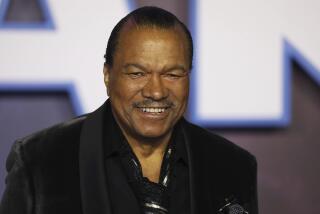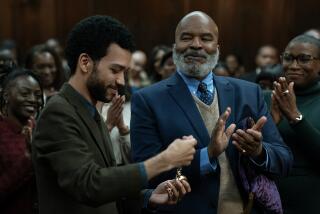Op-Ed: Transgressive casting? Forget Hollywood. Look to the stage.
The reboot of the much-beloved blockbuster threatened its hard-won legacy. The new version, in a misguided publicity stunt, had cast a woman in an iconic male part. “This absolutely masculine character is not capable of proper presentation by a woman, however great or talented,” one particularly incensed critic said.
So said the New York Mirror. Writing about actor Nellie Holbrook playing Hamlet. In 1880.
A century and a third later, newpapers have been supplanted, or at least supplemented, by Internet trolls. But the white dude pop-culture panic remains the same: loud, baseless and surprisingly effective at keeping mass entertainment exceedingly boring.
Shakespeare, the O.G. franchise creator, seems to have survived, and even thrived, despite that 1880 indignity and many a subsequent slight. In just the past year or so: Lady Petruchios! Black Lears! Black lady Hamlets!
Theater in general is having a much-lauded era of deliberately transgressive casting. There’s the cross-genre chart-topper “Hamilton,” race-bending our stuffy white founding fathers, and the all-female “Taming of the Shrew,” produced by the same New York theater that incubated Lin-Manuel Miranda’s cultural leviathan. And then there’s the sold-out London production of J.K. Rowling’s “Harry Potter” sequel, the one that cast black actor Noma Dumezweni as Hermione Granger, whose race was never described in Rowling’s books. Despite the predictable outrage from online racists, ticket demand for “Harry Potter and the Cursed Child” has reached sell-a-kidney levels, with some resold tickets going for $1,300 or worse.
It seems ridiculous, in light of all that evidence, to still have to refute a 19th-century critic. On stage, on television and in their rare opportunities on film, women and people of color have proved themselves “capable of proper presentation” in roles originally conceived for white men. More than capable, they’ve been deemed “fabulous,” “refreshing” and central to what’s becoming “one of the biggest critical and commercial hits in Broadway history.”
So why is this still a debate for Hollywood?
Why is irrational, virulent, baseless hatred — the sort that surfaces all too easily these days, the sort that temporarily forced “Ghostbusters” star Leslie Jones off Twitter this week — still so legitimized in the movie business? More insidiously: What will it take to delegitimize it?
Yes, this is a Marvel complaint, a James Bond grievance, even a “Doctor Who” protest. This summer alone, Hollywood has bestowed upon us the 13th entry in the “Avengers” movie universe with, as always, white men leading the ensemble; the ninth entry in the “X-Men” movie franchise, ditto; the third installment of the bro-filled, paint-by-numbers “Star Trek” reboot, this one getting praise and censure for a decision to retroactively out new-Sulu. And I’m already looking forward to next year, when I can avoid the sixth movie this century about a Spider-Man who is contractually obligated to be white, male and heterosexual.
This is also the summer that gave us the distaff “Ghostbusters,” which director Paul Feig and his stars turned into a public referendum on the question of Can Women Be in Hollywood. Answer: Not resoundingly enough at the first-week box office, and not on Twitter while black.
That’s a problem for all movie-goers, not just those of us who favor these soapboxes, because inclusive casting isn’t just a goal in and of itself.
Set aside, for a moment, the very valid criticism that these unimaginatively cast franchises are racist and sexist. Focus, instead, on the fact that they’re deathly dull. It’s become indescribably boring to watch the same dudes, with the same conventionally white side chicks and ethnically diverse sidekicks, carry out the same rote beats in the continuing sagas of the Hollywood franchises of today.
In an era when Hollywood is juicing its dependency on these never-ending story sequels, remakes and reboots, movie studios keep missing the most obvious lesson from their scrappier stage cousins: Nothing freshens up a worn narrative like putting new faces in familiar surroundings.
In other words: Come on, Hollywood. If you’re going to keep on telling the same stories, this one quick trick is all you need to instantly make them a lot more fun.
Maria Aspan is a senior editor at Inc. Magazine, where she covers money, tech and gender.
Follow the Opinion section on Twitter @latimesopinion or Facebook
More to Read
A cure for the common opinion
Get thought-provoking perspectives with our weekly newsletter.
You may occasionally receive promotional content from the Los Angeles Times.






